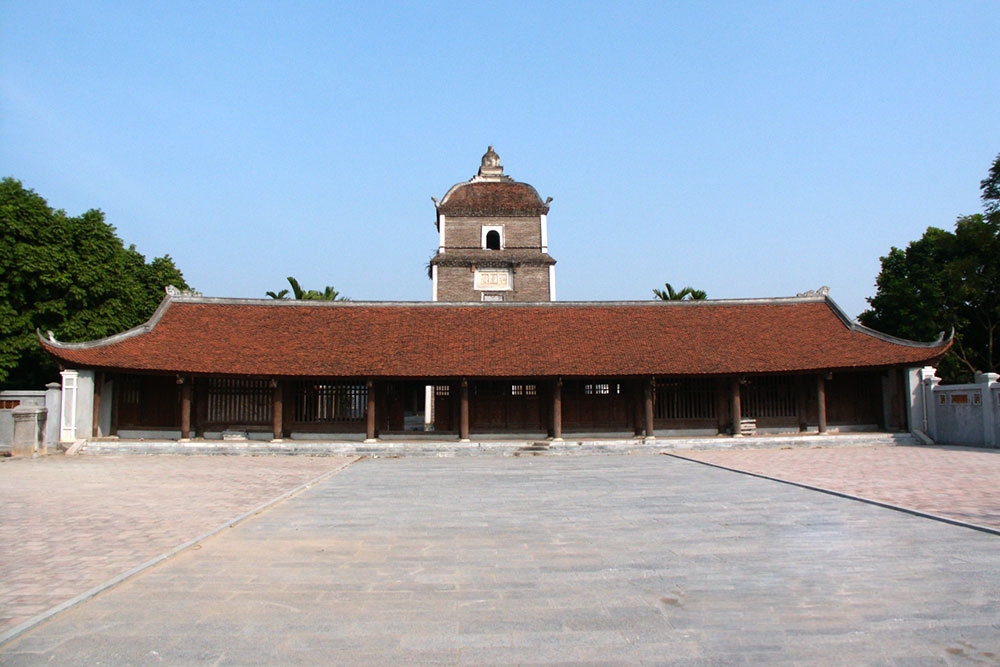The formation of each thing and the present, always goes hand in hand with its forming conditions. The formation of Dau pagoda is not outside the objective and subjective conditions leading to the birth of a religion or allowing the introduction of a religion, but here in the research paper is the introduction of religion. Religion- Buddhism
The first objective condition that we must mention is that the pervasive power of Buddhism has not only spread throughout India, but it has also crossed the border of the original country. It was born to spread to other countries around the world after Buddhism was born around the 6th century BC. Especially during the reign of King Asoka (3rd century BC), there were incentives to spread Buddhism outside the Indian territory.
The second objective condition as described above is that our country has an extremely favorable geographical position. is a common road on the sea, is “the crossroads of economic and cultural exchanges that foreign merchants often frequent to do business and trade. That’s why many Indian and Chinese merchants come to trade. Therefore, Buddhism could follow these merchants to spread into our country to form the Luy Lau Buddhist center, and the Dau Pagoda was also formed there.
The second factor she must mention here is that Buddhism, which is a folk religion, defending the weak and against the caste system in India, was propagated to Vietnam by the road of peace from the South up (India through Southeast Asian countries and then Vietnam), and from the North down from China. That is why, when Buddhism was introduced into Vietnam, it did not encounter any obstacles or prohibitions. And this is also the reason why Dau Duoc Pagoda was born early in the Luy Lau area, where the district was ruled by the Northern colonial government at that time.
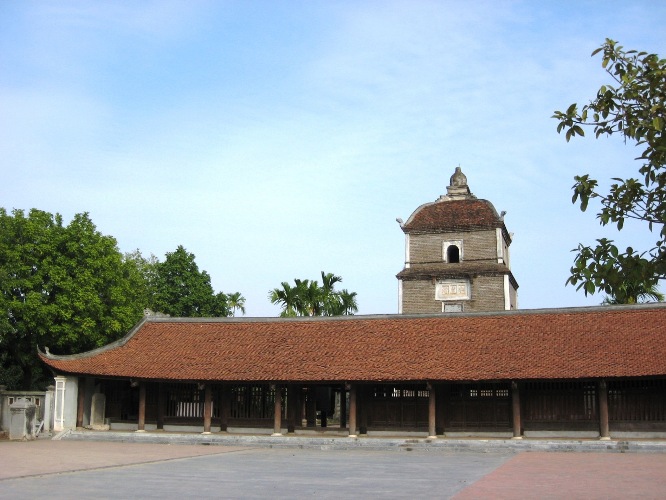
Besides the objective factors that led to the early birth of the Dau Pagoda as described above, there are also subjective factors leading to the formation of the Dau Pagoda in our country, which are:
Before the governing policies brutality along with extremely brutal methods of exploitation, in order to maximize the exploitation of natural resources, labor products as well as skilled workers to provide firstly for the local ruling apparatus. And the collection of water for the people of the Strawberry region at that time became extremely painful. That’s why the people here needed to come to a place for spiritual refuge, to hope for a good future, against the assimilation policy of the Han Dynasty at that time. Dau Pagoda was also born on that basis.
Another subjective factor that led to the birth of Dau Pagoda is the acculturation exchange in Vietnamese culture, which is the custom of ancestor worship, which is the element of respect for women, the respect of Vietnamese culture has quickly reconciled. merged with Buddhism to create a temple in the bustling commercial capital. Where everyone wants the business to be smooth, “trade is expensive”, ask the gods to help do business, the needs of people are increasing, the sooner the temple, where the prayer is conducted, will be released. life. And Dau Pagoda was formed from these conditions and factors.
2. Legend of the birth of Dau Pagoda
According to legend, the birth of Dau Pagoda is associated with the legend of the Buddha’s mother Man Nuong and the Four Dharma Buddha system (Phap Van – Phap Vu – Phap Loi – Phap Dien) Also known as (Clouds-Rain-Thunder-Lightning).
The character mentioned in the legend is the famous monk Gia La Do Le, also known as Monk Khau Da La, from Tay Truc (India) who came to preach in Luy Lau during the Han Dynasty. Domination, with the name of the ruler of Giao Chau district is the prefect Si Nie (187-226). Legend has it that the monk Khau Da La was a master of magic, practiced well with the practice of standing on one leg, so everyone respected and worshiped.
Not far from Linh Quang Pagoda, there is a family of Mr and Mrs. Tu Dinh, in Men Village (Ma Xa) who are rich in virtue and love Buddhism, and sent their only daughter to the temple to practice religion and help the pagoda family. chores such as cleaning, gathering firewood, cooking…
But one day a strange thing happened, unlike usual, after finishing cleaning everything in the temple, Man Nuong was so tired that she fell asleep on the doorstep. When monk Khau Da La finished chanting, he returned to his room to find Man Nuong sleeping. Because he didn’t want to wake her up, he walked over. Unexpectedly, “Human natural harmony” she became pregnant and had to go home to Tu Dinh’s grandparents to give birth.
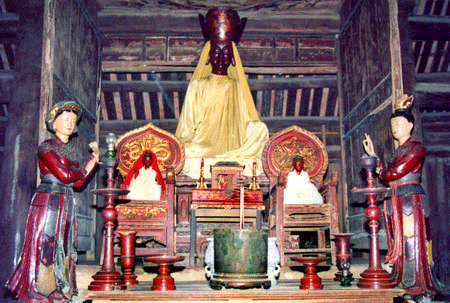
On the eighth day of the fourth lunar month, she gave birth to a baby girl who, when born, had a sweet fragrance, five-colored clouds, and a bright light shining everywhere.
Seeing that their daughter was “pregnant without a husband”, Mr and Mrs. To Dinh were ashamed of their neighbors and relatives, so they sent Man Nuong to bring the child back to the monk Khau Da La. The monk took the baby from Man Nuong’s hand, carried the baby to a tree in the temple, and tapped the tree to recite the mantra. Suddenly, the tree split in two, the monk put the baby inside, and the tree naturally closed again.
In a night of heavy rain and wind, the tree fell and drifted into the Dau River, and on that night, the prefect Si Niep dreamed that a god came to ask for a dream to be carved. After that, Si Hiep sent soldiers to pick up the tree, but many people could not pull it, only when Mrs. Man Nuong brought the bib back to pull it back. Thanks to that, the prefect To Dinh sent someone to find a talented craftsman who skillfully sculpted four statues. Legend has it that when sculpting the four statues, clouds, rain, thunder, and lightning appeared, so the new statues are named Phap Van, Phap Vu, Phap Loi, Phap Dien, also known as (Cloud-Rain-Thunder). – Flash ).After sculpting, the statue of Mrs. Dau could not be moved to another place, so it has been worshiped at a temple called Dau Pagoda ever since.
Above is a folk legend passed down from generation to generation to explain the birth of Dau Pagoda. Although it still contains many thrilling elements, when we analyze it and compare it with the national history, with Chinese records, we can confirm that Dau Pagoda was born around the 20th century. II, at the latest in the III century AD during the period when Si Nie ruled in our country (187-226 AD).
3. The process of construction and development of Dau
pagoda Dau pagoda is a temple to worship Mrs. Phap Van, who is peopleized as the eldest of four sisters in the Tu Phap pagoda system. Perhaps that is why the pagoda is also known as Ca pagoda, Co Chau Tu (precious jewel), Dien Ung Tu, and in the Ly dynasty, it was also called Thien Dinh Tu.
The reason why Dau Pagoda today is the main name of the temple is because in the past, the temple was located in the middle of a large plain where mulberry was grown to raise toothpicks to raise silk and weave silk. And the name Dau Pagoda was not only easy to remember for the majority of people who were uneducated at that time, but it also spoke about the characteristics of productive labor that were very close to the people’s consciousness.
The history of the formation and development of Dau pagoda from the Northern domination period is very little recorded in Vietnamese history as well as in Chinese bibliographies. It is mainly mentioned in the restoration work and the number of times of praying for the island to be inspired by the feudal kings and mandarins, recorded very briefly in Ngo Sy Lien’s “Dai Viet history history” or in the work. Dharma Van Buddha Hanh Language Luc. In a number of works during the colonial period, they also mainly recorded an overview of the appearance and landscape of the temple in the overall cultural-economic-political center that flourished in the work “Northern period of ancient stop “.
During the Northern domination period which lasted for thousands of years, due to historical conditions as well as very rare documents left behind, we could only know about the Luy Lau Buddhist center in “Central meditation practice” about the shamanist passage. Dam Thien told King Sui Van De after Hoa Chau returned: “The land of Giao Chau has a direct connection with Thien Truc. When Buddhism just arrived in Giang Dong was incomplete, there were 20 stupas in Luy Lau in Giao Chau, 500 monks, and 15 scriptures translated” (Tran Dinh Luyen, Preserving and promoting cultural heritage) Kinh Bac Culture, Culture and Information Publishing House, 2006, tr195). Therefore, we can confirm that Dau pagoda was built in the period I-II century AD. Then, due to the turmoil in China, a large number of monks had to flee to Giao Chau to take refuge and propagate Buddhism such as Maha-qi-region, Mau Tu,
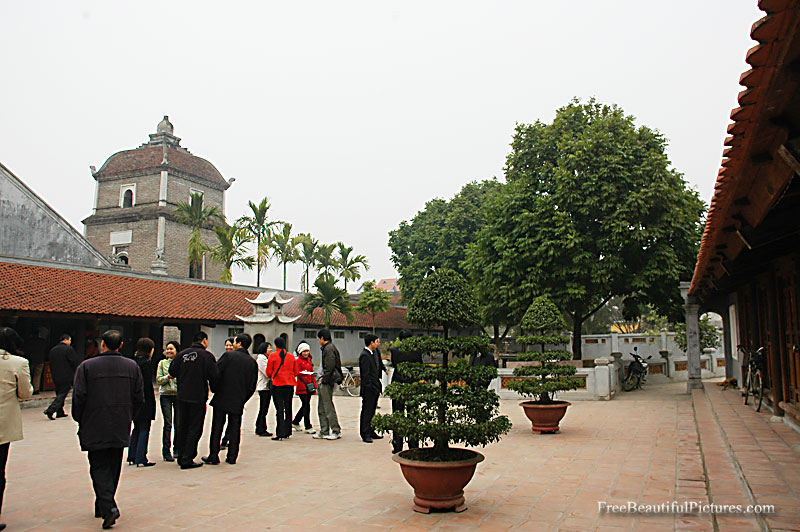
Located in the overview of the Luy Lau Buddhist center, it is certainly a condition that, at first, Dau Pagoda was established, it may have been a small place of am, coc. But since Buddhism developed in Luy Lau with successive high monks coming to the abbot, Dau Pagoda has been increasingly restored, built bigger and more beautiful.
Entering the feudal period, in order to consolidate power and rule over the entire territory, at this time Confucianism became too strict and harsh for the people to gain after thousands of years of Northern domination. liberty. Therefore, the Vietnamese feudal government during this period adopted Buddhism as the state religion. That is also the explanation why during the Ly-Tran dynasties, Buddhism flourished in our country, with a large number of pagodas built and restored, in which Dau pagoda cannot be missed.
Experiencing many ups and downs in history, it was not until 1752 that Dau Pagoda really entered the text by conducting the engraving of two sets of carved boards named “Co Chau Phap Van Phap”. Van Phat Ban Hanh” and the work “Hien Ancient Chau Phat To Nghi”: Talking about the history of formation and construction process, the temple was performed by the monk Tinh Mo (1706-1775) abbot and his disciples. These are works that talk about the story of Man Nuong and the Four Dharmas system, the process of construction, restoration and the number of times the kings and mandarins were recorded. Through comparison and comparison with other documents such as the Viet History, Dai Viet Su Ky Toan Thu, has recorded: “In the first month of the year of the Rat year (1072) when Ly Nhan Tong ascended the throne, on the eighth day of April, a ceremony was held. procession of Buddha, procession of Buddha statue of Phap Van to the sutras to pray for peace” (Viet Su Luoc). In the Dai Viet history book, it was written: “The second year of Quy Suu-Thai Ninh (1703), it was raining heavily at that time. The procession of the Buddha statue of Van to the sutra to pray for peace “… and perhaps it is because of the effectiveness of the Buddha statue in Dau pagoda that our country’s feudal dynasties have been greatly restored many times.
The biggest restoration of Dau Pagoda mentioned was in 1313, during the reign of King Tran Anh Tong, which was repaired by poinsettia Mac Dinh Chi. Legend has it that Dau pagoda was built with “9-storey tower, 9-span bridge, hundred-room pagoda”. However, researchers so far have not dared to confirm these statistics.
Dau Pagoda was built in the architectural style of “Noi Cong, Foreign”, with three buildings in front, burning incense, and upper hall, one after another like the letter of the public, and the entire area of more than 177m2 of the temple is surrounded by four buildings. national character wall. Going from the coffin to the entrance, the Tien Duong, burning incense, and upper hall were built up step by step. The façade is the widest with 7 compartments, late Nguyen style, corresponding to the absolute foolish age inscribed on the first sentence: “Kai Dinh dynasty three years, nine moons, nine days, restored Buddha wood received construction” and written on the upper salary: “Royal dynasty of Khai Dinh in the three decades of the first moon and ten days of the restoration and restoration of the universe of Thuong Luong Dai Cat” confirms that this building was redone in just over three months from September 9 to November 15, Khai Dinh 3 year. ie October 13, 1918 to December 17, 1918). Besides the two guardian statues as mentioned above,
Next to the front hall is the incense burning court with the altar of the three treasures, the two sides are decorated with the Ten Palaces of Hell. Next to the end of the wall on the left and right are two statues facing each other: poinsettia Mac Dinh Chi (who had merit in restoring and building the pagoda) and crown prince Ky Da.
The highest in the temple is the Upper Palace, one room and two left, with four curved roofs, shaped like a lotus, meticulously sculpted with very soft figures of the Four Spirits. skillful, skillful. This building was rebuilt in the Le Trung Hung period, but the stele at the door of the temple named “Dien Dien Dai Thien Tu Bi Ky” built in Vinh Thinh 12 (1716) said that at this time the old pagoda was damaged, his family Captain Cao Dinh Tax has paid for the renovation work, this building stands out in the middle with a 185cm high statue of Mrs. Phap Van, appearing with the gentleness and kindness of an oriental woman, and a photo imprint. Indian buddhist influence with a mole between the eyebrows. On the left hand side of Mrs. Phap Van is a statue of Phap Vu, 128cm high, which was brought to worship when Dau Pagoda was destroyed during the resistance war against the French. Both of these statues are painted with beautiful wing-colored paint. Standing next to the bride is a statue of Kim Dong and Ngoc Nu, with statues of a black lord and a white lord on both sides, below Thach Quang Buddha. With the density of statues arranged proportionally in the temple, the last corner on the right hand side of Buddha Dharma Van is the patriarch Ti Ni da luu chi, who has merit in developing the Zen Buddhism line to its peak, to Dau Pagoda became the first Zen Buddhism temple in Vietnam.
Connecting with the rear house is a long corridor, arranged by 18 familiar Thap Bat Arhat statues in the structure of Vietnamese pagodas. Particularly, the rear worship space has 15 statues according to the structure of the post-god Buddha of Vietnamese Buddhism. Especially in this post-worshiping space, there is also a glass cabinet containing 2 sets of carved boards telling about the story of Man Nuong and the process of building the pagoda as mentioned above. In addition, this shrine also contains the “post-Buddhist Bi Ky” stone steles of the Le Trung Hung, Tay Son and Nguyen dynasties.
Located in front of the front yard is the majestic Hoa Phong tower, familiar in the folk song: “No matter where anyone goes, whenever they see the Dau pagoda tower, they come back”, “It is said, formerly 9 floors high, built of large bricks, solidified like crockery, dark in color, outside neither plastered nor painted, now the tower has only 3 floors and is 17m high. The tower was built from the autumn of 1737 to the autumn of 1738, but it was renovated by monk Tinh Mo. In the hollow tower, the ground floor has four statues of Tu Tran, above it hangs a bell cast in the first year of King Canh Thinh (1793) of the Tay Son Dynasty. This bell is taken care of by the monk Chieu Tuyen, and the monk himself advises himself to “slowly speak, This clumsy pen ” did not hesitate to write down the excellent inscription and engrave it on the bell with the title “Co Chau Dien responds to the great meditation to create the common Dharma mantra”. Hanging next to the bronze bell is Khanh bronze, cast during the reign of Minh Mang 1818.
In the year of Canh Hung 1740, the Dau pagoda was destroyed by a fire, the ordinations from previous generations were all burned, so in 1741, Lord Trinh Doanh gave an edict for the Khuong Tu people to create a custom to take care of the temple, which will be exempted. The last major restoration
work in Vietnam’s feudal dynasties was in 1918 under the reign of King Khai Dinh, as described above.
Thus we can see that in the feudal dynasties of Vietnam, the Dau pagoda played an important role in the people’s life, was always restored and built by the feudal dynasties.
Since the Democratic Republic of Vietnam was established until now, at first due to the war, Dau Pagoda had no conditions for major restoration. But on April 28, 1962, Dau Pagoda was ranked by the state as a particularly important national historical relic that needs to be preserved and restored according to Decision No. 313- VH/QD.
The longest and most extensive restoration since 1975 is the one starting in 2001 with the approval of the Ministry of Culture and Information, with a budget of tens of billions of dong, to restore and restore the pagoda. Strawberries are worthy of a national cultural heritage. The pride is not only of the people of Giao Chau at one time, but also of the people of Kinh Bac in particular but of the whole Vietnamese nation today.
4. The position of Dau pagoda in the Four Dharma system
Dau Pagoda is one of four pagodas belonging to the Four Dharma Buddha system in Bac Ninh including: Phap Van, Phap Vu, Phap Loi, Phap Dien, and was born by the mother Buddha Man Nuong.
In the “blood” relationship, the bride is considered the first child, and also the eldest sister of the remaining three Phap Vu, Phap Loi, and Phap Dien. That is the relationship that does not fall, that the agricultural people always hope in the close relationship of humans before natural phenomena.
But through the image of the Four Dharmas, we can also see the logical thinking of the agricultural people in the way they view the world and human life. The early inhabitants of wet rice cultivation had to depend entirely on natural conditions, in which the weather factor played a very important role. That’s why there is a saying: “First country, second part, three needs, four varieties”. But to have rain, the necessary and sufficient condition here is to have clouds. That is why Dau Pagoda, where the Buddha Dharma is protected, is always worshiped and ranked in the most important position by the people.
Moreover, Dau Pagoda is also a place to mark the formation and development of Zen Buddhism in our country, from which it has the power to spread to all parts of the country, exist for many centuries, and become a feature of Zen Buddhism. indispensable in Vietnamese culture. Which is coincidental or inherently a sacred place, but the number of times of praying for islands at Dau Pagoda is inspired. That makes people believe in Buddhism, about the effectiveness of the Dau Pagoda, and respect and admire it even more.
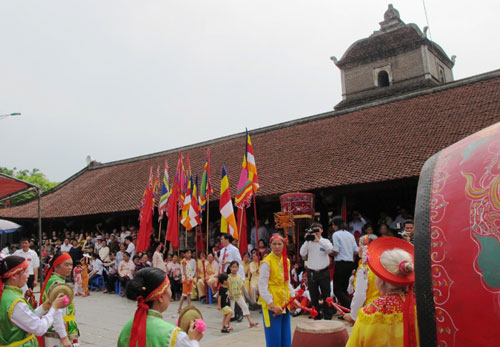
Perhaps because of the belief in the Buddhist system of four Dharmas, it was spread quite popularly to neighboring provinces and the Northern Delta region such as: the group of four Dharma pagodas in Thuong Tin district – Ha Tay province, the four Dharma groups in the northern region. at Set Pagoda, Thuong Phuc Strawberry Pagoda, Keo Pagoda in Hanoi, the Four Dharma Groups at Thai Lac Pagoda, Dai Bi Pagoda in Hung Yen… that Dr. Nguyen Manh Cuong has studied very carefully in the work “CREATIVE DRAIN – FOUR PHAP and SYSTEM OF QUALIFIC CURRENTS, Hanoi Social Publishing House, 2000”, here we would like not to repeat it again.
Every year, the Dau Pagoda festival on the 8th day of the 4th lunar month attracts tens of thousands of people from all over the world. It has become an indispensable place for community activities for people around the region and Buddhists from all over the country, including foreign tourists who want to learn about culture, festivals and the four dharma system. in Vietnam.
Source: Collected internet.
